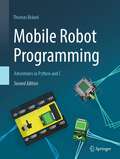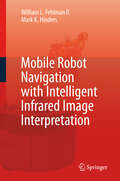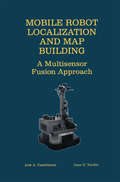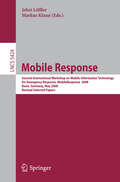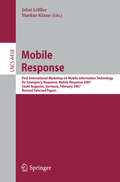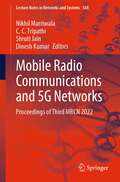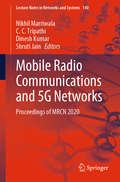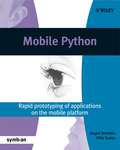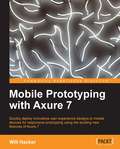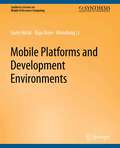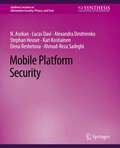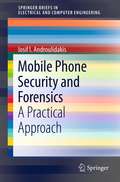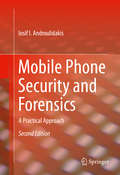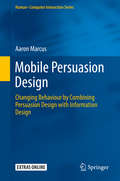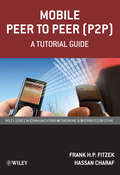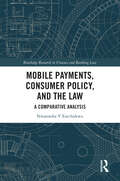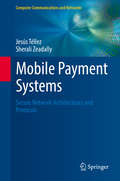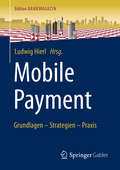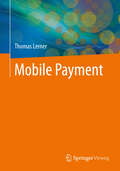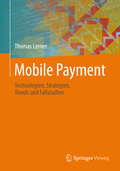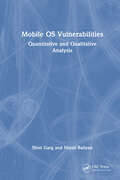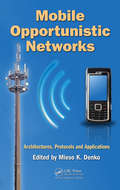- Table View
- List View
Mobile Robot Programming: Adventures in Python and C
by Thomas BräunlThis book emphasizes software design as the most important topic in modern robotics and demonstrates practical code examples in Python and C. The book introduces the free simulation system EyeSim in combination with EyeBot robots, which can be built from inexpensive embedded processors, sensors and motors – or by adapting the control inputs of model cars. EyeSim is a free software for MacOS, Windows and Linux, which uses a realistic physics simulation engine and is source-code compatible to the EyeBot mobile robots. So, each robot program can first be tested on the simulator before running it on a real robot. EyeSim includes modules for driving, walking, swimming and diving robots, as well as for robot manipulators. EyeSim also runs on the Meta/Oculus Quest, providing a fully immersive robotics experience in virtual reality. Beginning with simple driving algorithms and sensor data processing for distance sensors, Lidar and camera, the book progresses to more complex localization and navigation tasks, as well as vision-based navigation and genetic algorithms. It concludes with artificial intelligence applications for mobile robots in traffic scenarios and full-size autonomous vehicles. This book is suitable as a text for undergraduate and graduate courses in Robotics, Automation and Artificial Intelligence, as well as a self-study guide for practitioners and hobbyists. All robot application programs in this book are available as free downloads for MacOS, Windows, Linux, and Raspberry Pi OS.
Mobile Robot Navigation with Intelligent Infrared Image Interpretation
by William L. Fehlman Mark K. HindersMobile robots require the ability to make decisions such as "go through the hedges" or "go around the brick wall." Mobile Robot Navigation with Intelligent Infrared Image Interpretation describes in detail an alternative to GPS navigation: a physics-based adaptive Bayesian pattern classification model that uses a passive thermal infrared imaging system to automatically characterize non-heat generating objects in unstructured outdoor environments for mobile robots. The resulting classification model complements an autonomous robot’s situational awareness by providing the ability to classify smaller structures commonly found in the immediate operational environment.
Mobile Robot Localization and Map Building: A Multisensor Fusion Approach
by Jose A. Castellanos Juan D. TardósDuring the last decade, many researchers have dedicated their efforts to constructing revolutionary machines and to providing them with forms of artificial intelligence to perform some of the most hazardous, risky or monotonous tasks historically assigned to human beings. Among those machines, mobile robots are undoubtedly at the cutting edge of current research directions. A rough classification of mobile robots can be considered: on the one hand, mobile robots oriented to human-made indoor environments; on the other hand, mobile robots oriented to unstructured outdoor environments, which could include flying oriented robots, space-oriented robots and underwater robots. The most common motion mechanism for surface mobile robots is the wheel-based mechanism, adapted both to flat surfaces, found in human-made environments, and to rough terrain, found in outdoor environments. However, some researchers have reported successful developments with leg-based mobile robots capable of climbing up stairs, although they require further investigation. The research work presented here focuses on wheel-based mobile robots that navigate in human-made indoor environments. The main problems described throughout this book are: Representation and integration of uncertain geometric information by means of the Symmetries and Perturbations Model (SPmodel). This model combines the use of probability theory to represent the imprecision in the location of a geometric element, and the theory of symmetries to represent the partiality due to characteristics of each type of geometric element. A solution to the first location problem, that is, the computation of an estimation for the mobile robot location when the vehicle is completely lost in the environment. The problem is formulated as a search in an interpretation tree using efficient matching algorithms and geometric constraints to reduce the size of the solution space. The book proposes a new probabilistic framework adapted to the problem of simultaneous localization and map building for mobile robots: the Symmetries and Perturbations Map (SPmap). This framework has been experimentally validated by a complete experiment which profited from ground-truth to accurately validate the precision and the appropriateness of the approach. The book emphasizes the generality of the solutions proposed to the different problems and their independence with respect to the exteroceptive sensors mounted on the mobile robot. Theoretical results are complemented by real experiments, where the use of multisensor-based approaches is highlighted.
Mobile Response: Second International Workshop on Mobile Information Technology for Emergency Responce 2008, Bonn, Germany, May 29-30, 2008, Revised Selected Papers (Lecture Notes in Computer Science #5424)
by Jobst Löffler Markus KlannMobile Response 2008, the Second International Workshop on Mobile Infor- tion Technology for Emergency Response, aimed at a focussed exchange on how mobile information technology can be e?ectively used to the bene?t of em- gency response. The gap between the great potential bene?t that usable mobile IT could yield in the domain of emergency response and the speci?c design challenges for such technologies in this particularly unforgiving domain was the foundation of our decision to create a venue for researchers and practitioners from di?erent disciplines. During this year’s workshopthe latest approachesand technical solutions in the area of mobile information technology for emergency response planning and execution were presented and demonstrated. We invited participation from research, industry and public rescue orga- zations to enable an in-depth discussion of the opportunities and drawbacks of new digital technologies for emergency response. The call for papers for the second Mobile Response workshop attracted over 25 submissions from 11 d- ferent countries, including international submissions from the USA, Brazil and Japan.AninternationalProgramCommitteewithexpertsonmobileinformation technology, emergency response and emergency response equipment selected 12 submissions for presentation during the workshop. The program was completed by two outstanding keynote presentations and one invited presentation on p- vailing topics of high interest to the scienti?c and practitioner communities.
Mobile Response: First International Workshop on Mobile Information Technology, for Emergency Response, Mobile Response 2007, Sankt Augustin, Germany, February 22-23, 2007. Revised Selected Papers (Lecture Notes in Computer Science #4458)
by Jobst Löffler Markus KlannThis book constitutes the thoroughly refereed post-proceedings of the First International Workshop on Mobile Information Technology for Emergency Response, MobileResponse 2007 held in Sankt Augustin, Germany in February 2007. The 16 revised papers presented together with one keynote lecture were carefully reviewed and selected. The papers are organized in topical sections on medical services, team support, geospatial information, wearable computing, and communication technology.
Mobile Radio Communications and 5G Networks: Proceedings of Third MRCN 2022 (Lecture Notes in Networks and Systems #588)
by Dinesh Kumar Shruti Jain Nikhil Marriwala C. C. TripathiThis book features selected high-quality papers from the Third International Conference on Mobile Radio Communications and 5G Networks (MRCN 2022), held at University Institute of Engineering and Technology, Kurukshetra University, Kurukshetra, India, during June 10–12, 2022. The book features original papers by active researchers presented at the International Conference on Mobile Radio Communications and 5G Networks. It includes recent advances and upcoming technologies in the field of cellular systems, 2G/2.5G/3G/4G/5G, and beyond, LTE, WiMAX, WMAN, and other emerging broadband wireless networks, WLAN, WPAN, and various home/personal networking technologies, pervasive and wearable computing and networking, small cells and femtocell networks, wireless mesh networks, vehicular wireless networks, cognitive radio networks and their applications, wireless multimedia networks, green wireless networks, standardization of emerging wireless technologies, power management and energy conservation techniques.
Mobile Radio Communications and 5G Networks: Proceedings of MRCN 2020 (Lecture Notes in Networks and Systems #140)
by Nikhil Marriwala C. C. Tripathi Dinesh Kumar Shruti JainThe book features original papers by active researchers presented at the International Conference on Mobile Radio Communications and 5G Networks. It includes recent advances and upcoming technologies in the field of cellular systems, 2G/2.5G/3G/4G/5G and beyond, LTE, WiMAX, WMAN, and other emerging broadband wireless networks, WLAN, WPAN, and various home/personal networking technologies, pervasive and wearable computing and networking, small cells and femtocell networks, wireless mesh networks, vehicular wireless networks, cognitive radio networks and their applications, wireless multimedia networks, green wireless networks, standardization of emerging wireless technologies, power management and energy conservation techniques.
Mobile Python: Rapid prototyping of applications on the mobile platform (Symbian Press)
by Jürgen Scheible Ville TuulosMobile Python is the introduction of Python programming language to the mobile space. This practical hands-on book teaches readers how to realize their application ideas on the Symbian OS. Programming on the Symbian mobile platform has been difficult and time consuming in the past. This innovative new title will remedy this problem. Chapters deal with topics that are based on Python S60 features and presented in an order that lets the user learn first the “simple to code” ones and then increasing in complexity.
Mobile Prototyping with Axure 7
by Will HackerThis book is a step-by-step tutorial which includes hands-on examples and downloadable Axure files to get you started with mobile prototyping immediately. You will learn how to develop an application from scratch, and will be guided through each and every step.If you are a mobile-centric developer/designer, or someone who would like to take their Axure prototyping skills to the next level and start designing and testing mobile prototypes, this book is ideal for you. You should be familiar with prototyping and Axure specifically, before you read this book.
Mobile Platforms and Development Environments (Synthesis Lectures on Mobile & Pervasive Computing)
by Sumi Helal Raja Bose Wendong LiMobile platform development has lately become a technological war zone with extremely dynamic and fluid movement, especially in the smart phone and tablet market space. This Synthesis lecture is a guide to the latest developments of the key mobile platforms that are shaping the mobile platform industry. The book covers the three currently dominant native platforms -- iOS, Android and Windows Phone -- along with the device-agnostic HTML5 mobile web platform. The lecture also covers location-based services (LBS) which can be considered as a platform in its own right. The lecture utilizes a sample application (TwitterSearch) that the authors show programmed on each of the platforms. Audiences who may benefit from this lecture include: (1) undergraduate and graduate students taking mobile computing classes or self-learning the mobile platform programmability road map; (2) academic and industrial researchers working on mobile computing R&D projects; (3) mobile app developers for a specific platform who may be curious about other platforms; (4) system integrator consultants and firms concerned with mobilizing businesses and enterprise apps; and (5) industries including health care, logistics, mobile workforce management, mobile commerce and payment systems and mobile search and advertisement. Table of Contents: From the Newton to the iPhone / iOS / Android / Windows Phone / Mobile Web / Platform-in-Platform: Location-Based Services (LBS) / The Future of Mobile Platforms / TwitterSearch Sample Application
Mobile Platform Security (Synthesis Lectures on Information Security, Privacy, and Trust)
by N. Asokan Lucas Davi Alexandra DmitrienkoRecently, mobile security has garnered considerable interest in both the research community and industry due to the popularity of smartphones. The current smartphone platforms are open systems that allow application development, also for malicious parties. To protect the mobile device, its user, and other mobile ecosystem stakeholders such as network operators, application execution is controlled by a platform security architecture. This book explores how such mobile platform security architectures work. We present a generic model for mobile platform security architectures: the model illustrates commonly used security mechanisms and techniques in mobile devices and allows a systematic comparison of different platforms. We analyze several mobile platforms using the model. In addition, this book explains hardware-security mechanisms typically present in a mobile device. We also discuss enterprise security extensions for mobile platforms and survey recent research in the area of mobile platform security. The objective of this book is to provide a comprehensive overview of the current status of mobile platform security for students, researchers, and practitioners.
Mobile Phone Security and Forensics: A Practical Approach (SpringerBriefs in Electrical and Computer Engineering)
by I.I. AndroulidakisMobile Phone Security and Forensics provides both theoretical and practical background of security and forensics for mobile phones. The author discusses confidentiality, integrity, and availability threats in mobile telephones to provide background for the rest of the book. Security and secrets of mobile phones are discussed including software and hardware interception, fraud and other malicious techniques used “against” users. The purpose of this book is to raise user awareness in regards to security and privacy threats present in the use of mobile phones while readers will also learn where forensics data reside in the mobile phone and the network and how to conduct a relevant analysis.
Mobile Phone Security and Forensics: A Practical Approach (Springerbriefs In Electrical And Computer Engineering Ser.)
by Iosif I. AndroulidakisThis new edition provides both theoretical and practical background of security and forensics for mobile phones. The author discusses confidentiality, integrity, and availability threats in mobile telephones to provide background for the rest of the book. Security and secrets of mobile phones are discussed including software and hardware interception, fraud and other malicious techniques used “against” users. The purpose of this book is to raise user awareness in regards to security and privacy threats present in the use of mobile phones while readers will also learn where forensics data reside in the mobile phone and the network and how to conduct a relevant analysis. The information on denial of service attacks has been thoroughly updated for the new edition. Also, a major addition to this edition is a section discussing software defined radio and open source tools for mobile phones.
Mobile Phone Programming: and its Application to Wireless Networking
by Frank H. P. Fitzek Frank ReichertThis book provides a solid overview of mobile phone programming for readers in both academia and industry. Coverage includes all commercial realizations of the Symbian, Windows Mobile and Linux platforms. The text introduces each programming language (JAVA, Python, C/C++) and offers a set of development environments "step by step," to help familiarize developers with limitations, pitfalls, and challenges.
Mobile Persuasion Design: Changing Behaviour by Combining Persuasion Design with Information Design (Human–Computer Interaction Series)
by Aaron MarcusMobile Persuasion Design presents ten conceptual design projects (or ‘Machines’) for new mobile application's (smartphone or tablet with Web portals) that combine theories of persuasion and information design to change people’s behaviour. Areas such as the environment, health, learning and happiness are explored, looking at ways of marrying people’s wants and needs to make simple, usable and desirable mobile applications. A user-centred design approach has been used, adopting user experience (UX) methods, in-depth case studies and market analysis to see what a modern user needs from their mobile application. By applying concepts like persuasion theory and information architecture, try to find ways to satisfy these needs and positively change their user habits.In 2011, the Green, Health, and Money Machines won design awards in an international competition hosted by the International Institute for Information Design, Vienna.
Mobile Peer to Peer: A Tutorial Guide (Wiley Series on Communications Networking & Distributed Systems #29)
by Frank H. P. Fitzek Hassan CharafExplore the potential of mobile P2P networks Mobile Peer to Peer (P2P): A Tutorial Guide discusses the potential of wireless communication among mobile devices forming mobile peer to peer networks. This book provides the basic programming skills required to set up wireless communication links between mobile devices, offering a guide to the development process of mobile peer to peer networks. Divided into three sections, Part I briefly introduces the basics of wireless technologies, mobile architectures, and communication protocols. Detailed descriptions of Bluetooth, IEEE802.11, and cellular communication link are given and applied to potential communication architectures. Part II focuses on programming for individual wireless technologies, and gives an understanding of the programming environment for individual wireless technologies. In addition, Part III provides advanced examples for mobile peer to peer networks. Introduces the basics of short-range/wireless technologies (such as Bluetooth and IEEE 802.11 Wireless LAN), mobile architectures, and communication protocols Explains the basic programming environment and the basic wireless communication technologies such as Bluetooth, WiFi (IEEE802.11), and cellular communication examples Discusses the advancements in meshed networks, mobile social networks and cooperative networks Provides detailed examples of mobile peer to peer communication including, social mobile networking, cooperative wireless networking, network coding, and mobile gaming Includes an accompanying website containing programming examples as source code Mobile Peer to Peer (P2P): A Tutorial Guideis an invaluable reference for advanced students on wireless/mobile communications courses, and researchers in various areas of mobile communications (mashups, social mobile networks, network coding, etc.) Undergraduate students and practitioners wishing to learn how to build mobile peer to peer networks will also find this book of interest.
Mobile Payments, Consumer Policy and the Law: A Comparative Analysis (Routledge Research in Finance and Banking Law)
by Nwanneka V. EzechukwuMobile technology offers an innovative and cost-effective channel for delivering a range of financial services, including mobile payments. In some jurisdictions, mobile payments simply provide a convenient option for facilitating payment transactions. In other jurisdictions, mobile payments are viewed as potentially transformative because they present an opportunity to expand access to financial services. However, as with other innovations, mobile payments raise consumer protection concerns and require robust regulatory mechanisms to address such concerns. Against this backdrop, the book adopts a typology of consumer policy tools which can be used to address the identified consumer concerns. This typology guides the enquiry into the existing consumer protection frameworks applying to mobile payments in selected jurisdictions (Canada, Kenya, and the United Kingdom). The main objective of this endeavour is to identify best practices that national authorities seeking to leverage mobile payments and similar innovations can emulate. This book will be of interest to policymakers, regulators, industry stakeholders, students, and scholars interested in the regulation of innovative financial services, particularly from a consumer protection perspective.
Mobile Payments, Consumer Policy and the Law: A Comparative Analysis (Routledge Research in Finance and Banking Law)
by Nwanneka V. EzechukwuMobile technology offers an innovative and cost-effective channel for delivering a range of financial services, including mobile payments. In some jurisdictions, mobile payments simply provide a convenient option for facilitating payment transactions. In other jurisdictions, mobile payments are viewed as potentially transformative because they present an opportunity to expand access to financial services. However, as with other innovations, mobile payments raise consumer protection concerns and require robust regulatory mechanisms to address such concerns. Against this backdrop, the book adopts a typology of consumer policy tools which can be used to address the identified consumer concerns. This typology guides the enquiry into the existing consumer protection frameworks applying to mobile payments in selected jurisdictions (Canada, Kenya, and the United Kingdom). The main objective of this endeavour is to identify best practices that national authorities seeking to leverage mobile payments and similar innovations can emulate. This book will be of interest to policymakers, regulators, industry stakeholders, students, and scholars interested in the regulation of innovative financial services, particularly from a consumer protection perspective.
Mobile Payment Systems: Secure Network Architectures and Protocols (Computer Communications and Networks)
by Jesús Téllez Sherali ZeadallyThis important text/reference presents the latest research and developments in the field of mobile payment systems (MPS), covering issues of mobile device security, architectures and models for MPS, and transaction security in MPS. Topics and features: introduces the fundamental concepts in MPS, discussing the benefits and disadvantages of such systems, and the entities that underpin them; reviews the mobile devices and operating systems currently available on the market, describing how to identify and avoid security threats to such devices; examines the different models for mobile payments, presenting a classification based on their core features; presents a summary of the most commonly used cryptography schemes for secure communications; outlines the key challenges in MPS, covering security for ubiquitous mobile commerce and usability issues; highlights the opportunities offered by mobile cloud computing and vehicular ad hoc networks in the design and development of MPS.
Mobile Payment: Grundlagen – Strategien – Praxis (Edition Bankmagazin)
by Ludwig HierlDieser Band aus der Edition BANKMAGAZIN bietet einen umfassenden Überblick der Grundlagen und Strategien im mobilen Zahlungsverkehr. Die wirtschaftlichen Rahmenbedingungen werden dargestellt und die Herausforderungen und Voraussetzungen für eine erfolgreiche Marktetablierung von Mobile Payment werden aufgezeigt. Kann Mobile Payment das Bargeld als führendes Bezahlinstrument im Handel ablösen? Weitere Schwerpunkte sind potenzielle Transaktionswege, Sicherheitsstandards und Betrugserkennung. Zudem geben Praktiker Einblick in ausgewählte Ansätze und Projekte, u.a. Payback, Paydirekt und Postbank. Auch Ansätze aus Großbritannien und Schweden werden vorgestellt.
Mobile Payment
by Thomas LernerPaying with mobile devices such as mobile phones or smart phones will expand worldwide in the coming years. This development provides opportunities for various industries (banking, telecommunications, credit card business, manufacturers, suppliers, retail) and for consumers.The book comprehensively describes current status, trends and critical aspects of successful mobile payment. It combines theory and practice. Comprising essential aspects of a successful mobile payment as well as successful case studies and practical examples, this book is for all who are developing, offering and using mobile payment.
Mobile Payment: Technologien, Strategien, Trends und Fallstudien
by Thomas LernerDas Bezahlen mit mobilen Endgeräten wie Handys oder Smartphones wird in den nächsten Jahren in Deutschland stark zunehmen. Dies bietet Chancen für verschiedene Branchen und für Verbraucher. Der Autor beschreibt umfassend den aktuellen Stand der Entwicklung sowie die wesentlichen Aspekte des Mobile Payment wie etwa Geschäftsmodelle, Technik und Sicherheit. Ergänzt wird diese Darstellung durch erfolgreiche Beispiele aus der Praxis und Fallstudien. Das Buch richtet sich an alle, die das Bezahlen mit mobilen Endgeräten entwickeln, anbieten oder nutzen.
Mobile OS Vulnerabilities: Quantitative and Qualitative Analysis
by Shivi Garg Niyati BaliyanThis is book offers in-depth analysis of security vulnerabilities in different mobile operating systems. It provides methodology and solutions for handling Android malware and vulnerabilities and transfers the latest knowledge in machine learning and deep learning models towards this end. Further, it presents a comprehensive analysis of software vulnerabilities based on different technical parameters such as causes, severity, techniques, and software systems’ type. Moreover, the book also presents the current state of the art in the domain of software threats and vulnerabilities. This would help analyze various threats that a system could face, and subsequently, it could guide the securityengineer to take proactive and cost-effective countermeasures. Security threats are escalating exponentially, thus posing a serious challenge to mobile platforms. Android and iOS are prominent due to their enhanced capabilities and popularity among users. Therefore, it is important to compare these two mobile platforms based on security aspects. Android proved to be more vulnerable compared to iOS. The malicious apps can cause severe repercussions such as privacy leaks, app crashes, financial losses (caused by malware triggered premium rate SMSs), arbitrary code installation, etc. Hence, Android security is a major concern amongst researchers as seen in the last few years. This book provides an exhaustive review of all the existing approaches in a structured format. The book also focuses on the detection of malicious applications that compromise users' security and privacy, the detection performance of the different program analysis approach, and the influence of different input generators during static and dynamic analysis on detection performance. This book presents a novel method using an ensemble classifier scheme for detecting malicious applications, which is less susceptible to the evolution of the Android ecosystem and malware compared to previous methods. The book also introduces an ensemble multi-class classifier scheme to classify malware into known families. Furthermore, we propose a novel framework of mapping malware to vulnerabilities exploited using Android malware’s behavior reports leveraging pre-trained language models and deep learning techniques. The mapped vulnerabilities can then be assessed on confidentiality, integrity, and availability on different Android components and sub-systems, and different layers.
Mobile OS Vulnerabilities: Quantitative and Qualitative Analysis
by Shivi Garg Niyati BaliyanThis is book offers in-depth analysis of security vulnerabilities in different mobile operating systems. It provides methodology and solutions for handling Android malware and vulnerabilities and transfers the latest knowledge in machine learning and deep learning models towards this end. Further, it presents a comprehensive analysis of software vulnerabilities based on different technical parameters such as causes, severity, techniques, and software systems’ type. Moreover, the book also presents the current state of the art in the domain of software threats and vulnerabilities. This would help analyze various threats that a system could face, and subsequently, it could guide the securityengineer to take proactive and cost-effective countermeasures. Security threats are escalating exponentially, thus posing a serious challenge to mobile platforms. Android and iOS are prominent due to their enhanced capabilities and popularity among users. Therefore, it is important to compare these two mobile platforms based on security aspects. Android proved to be more vulnerable compared to iOS. The malicious apps can cause severe repercussions such as privacy leaks, app crashes, financial losses (caused by malware triggered premium rate SMSs), arbitrary code installation, etc. Hence, Android security is a major concern amongst researchers as seen in the last few years. This book provides an exhaustive review of all the existing approaches in a structured format. The book also focuses on the detection of malicious applications that compromise users' security and privacy, the detection performance of the different program analysis approach, and the influence of different input generators during static and dynamic analysis on detection performance. This book presents a novel method using an ensemble classifier scheme for detecting malicious applications, which is less susceptible to the evolution of the Android ecosystem and malware compared to previous methods. The book also introduces an ensemble multi-class classifier scheme to classify malware into known families. Furthermore, we propose a novel framework of mapping malware to vulnerabilities exploited using Android malware’s behavior reports leveraging pre-trained language models and deep learning techniques. The mapped vulnerabilities can then be assessed on confidentiality, integrity, and availability on different Android components and sub-systems, and different layers.
Mobile Opportunistic Networks: Architectures, Protocols and Applications
by Mieso K. DenkoThe widespread availability of mobile devices coupled with recent advancements in networking capabilities make opportunistic networks one of the most promising technologies for next-generation mobile applications. Are you ready to make your mark? Featuring the contributions of prominent researchers from academia and industry, Mobile Opportunistic N
